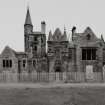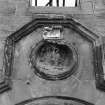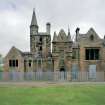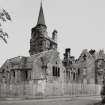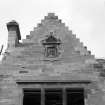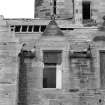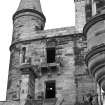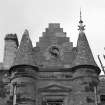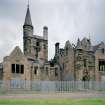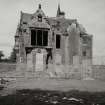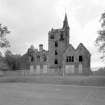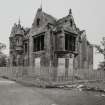New Stevenston, Wrangholm Hall
Term Pending (Period Unassigned)
Site Name New Stevenston, Wrangholm Hall
Classification Term Pending (Period Unassigned)
Alternative Name(s) Carfin Hall
Canmore ID 200583
Site Number NS75NE 109
NGR NS 76259 58952
Datum OSGB36 - NGR
Permalink http://canmore.org.uk/site/200583
- Council North Lanarkshire
- Parish Bothwell (Motherwell)
- Former Region Strathclyde
- Former District Motherwell
- Former County Lanarkshire
NS75NE 109 76259 58952
Wrangholm Hall is depicted on the OS 2nd Edition map (Lanarkshire, sheet XII, 1899). It has since been demolished.
Information from RCAHMS (HMLB), October 2001.
" Carfin Hall was built after 1871 and before 1880. Its owner Alexander Gray Simpson quit the property in 1880 after some few years of ownership. In his autobiography, Life of a Miner in Both Hemispheres, Abbey Press, 1903, Alexander Gray Simpson says it cost twelve thousand pounds to build and furnish. The architect was John Burnet, presumably John Burnet, (elder) b1814, d1901, who is given in The Book of Scotsmen Eminent For Achievements by Joseph Irving, published 1881, as 'an architect of high reputation for mansion houses, public buildings and churches among which are Arden House, Auchindennan House and Kilmahew Castle in Dunbartonshire; The Clydesdale Bank, Merchants' House and Stock Exchange Glasgow'. However his son John James Burnet, b1857, d1938, also an architect is a possibility. Alexander Gray Simpson was a coalmaster with coal interests in Wishaw, Carfin, Shotts (all Lanarkshire) and Irvine (Ayrshire). He was a founding member of the Glasgow Coal Exchange, Chief Magistrate of Wishaw and after 1877 Convener of the Blantyre Accident Relief Fund. Following a collapse in the coal trade, he emigrated to America in 1880, leaving Carfin Hall. Ironmaster James Neilson occupied the property in 1891. Alexander Gray Simpson devotes the best part of a chapter of his autobiography to Carfin Hall, the relevant parts of which are as follows: " I conceived the idea of building a home on my Carfin property. I consulted John Burnet, the architect, who shortly after provided me with plans. These at the first blush were laid aside as altogether more expensive than I felt necessary, although my family was then large and considerable accommodation was required at the time. The plans were, however, taken up by my wife and myself at odd times till they became part of ourselves, and at the end of two years we had both tacitly accepted them in our minds and resolved to build. The position was this: there were the plans and estimates giving all the accommodations that we could ever possibly want, sufficient money was lying idle to execute them: and they were adopted and Carfin Hall was built.The avenues, walks and plantations I laid out myself and so carefully had I studied the plans that not a single alteration was made during the building of the large structure. The Hall contained twenty rooms, two lodges, coachmen's house, stables, conservatory, etc., with an artificial lake in front. The lake gave me considerable anxiety about the time it was finished ready to receive the water. I had laid the bottom and around the sides with fire-clay pavement made specially for the purpose at the extensive brick-work I had in connection with my Carfin work. As usual the family were spending the summer at the coast, and on one of my weekly visits to them I took a book out of the library, which happened to be 'Chambers's journal,' and turning over the pages carelessly my attention was attracted to an article headed 'A Draw.' I read a few lines to see what they meant and speedily got interested, so sat down and perused it carefully. It went on to say how a gentleman had built himself a handsome country house and to add to its beauty had formed a lake in front of it, but soon after it was filled with water he found frogs flocking from every point of the compass to it, and in two weeks' time they numbered thousands. Their croaking so near his front door was unbearable; every effort he made to get rid of them was futile, and in the end he had to fill up the lake and make it into a flower garden. I could not make up my mind as to whether the article was in sober earnest or a joke, and my lake being finished and at so great expense I concluded to try it anyhow. Immediately I got to Carfin, I caused the water to be let on, and with considerable anxiety, which I kept to myself, my first morning visit was to the lake. For a couple of weeks no frogs appeared, I concluded the article was a joke, but a few days later a dozen or more heads popped up as I approached and my anxiety was renewed. It seemed a double misfortune, for besides enhancing the beauty of the grounds the water was filtered by a drain to a well in the court, pumped up into a cistern in the tower, and then used for all purposes inside-indeed it was the only water available, as the underground workings in the neighborhood had long before drained all the wells. In two more weeks the lake was literally crowded with frogs, and as it was their breeding season the sight was unbearable. I first got all the published works I could lay my hands on, studied the species zealously, but failed to find any way of destroying them without injuring the water. I then swallowed my temerity and consulted everyone I met-clergymen, doctors, workmen. All failed to suggest an antidote except Paddy Mitchell, an old workman of my own. He recommended me to 'Get over a cargo of Emerald soil, spread it all round the lake, and I will go bail they will all go off.' As to whether St. Patrick really 'Gave the frogs and toads a twistAnd banished them forever' from ould Ireland was then, and for that matter is still, an open question with me, and much as I felt exercised over my trouble, I did not feel like taking the risk of being laughed at, so I let Paddy's well-meant suggestion go. It is the trifles of life that worry and annoy, and I am quite free to say I felt more over this matter, and perhaps used more adjectives in connection with it, than I care now to remember. One morning the recollection came into my mind of the piece of lime found in the Virtue Well [Airdrie] from which, as a little boy, I had taken water to my sick grandmother, and on my father's statement that it had been thrown into the well to purify the water, I at once said to myself, If lime cleared the Virtue Well why should it not clear the lake? So Paddy Mitchell was at once sent to the work for a load of lime-shells with instructions to break it in pieces to the size of his hand and throw them all over the lake.During the following night the frogs took their departure and in the morning not a single one was to be seen! And every spring since, so soon as they begin to collect, the same process is gone through with a like result." "
Information supplied by Donald Simpson, based on personal research. Added 24 July 2007. (PJG)























